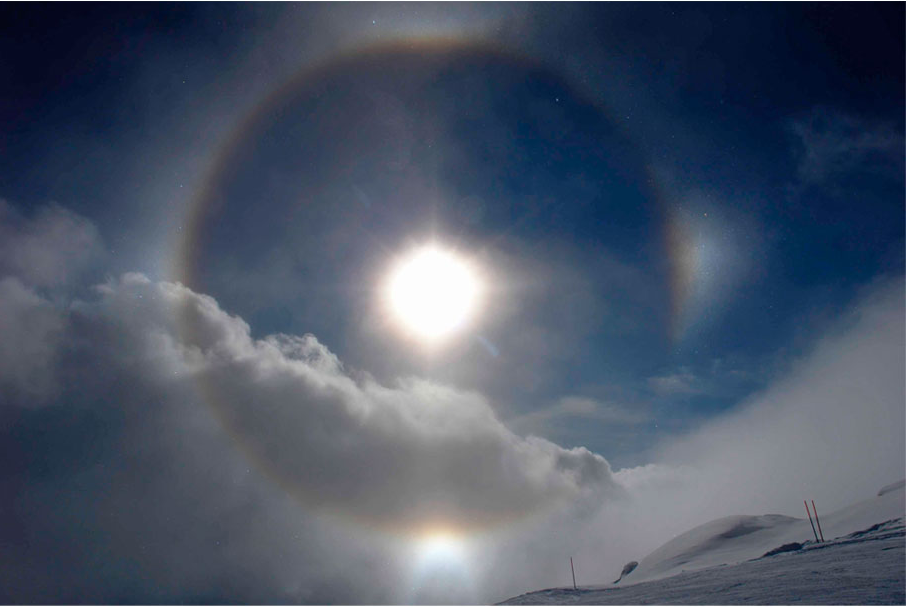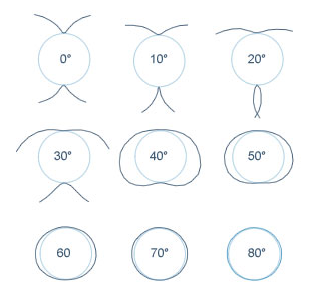OPOD - Tangent Arcs
OPOD - Tangent Arcs: A Spectacular Atmospheric Phenomenon
When it comes to atmospheric optics, there are a myriad of captivating and awe-inspiring phenomena to explore. One such phenomenon that never fails to amaze is the occurrence of tangent arcs. These arcs, which appear at the top and bottom of the 22° halo, add an extra touch of beauty and complexity to the already stunning display.
The 22° halo, a circular halo produced by non-oriented crystals, is a dominant feature in the sky during certain atmospheric conditions. However, it is the presence of tangent arcs that truly sets this optical display apart. These arcs are formed by hexagonal column crystals that are suspended in the air with their long axes almost horizontal.
As the sun rises higher in the sky, the shape of the tangent arcs undergoes a dramatic transformation. Initially appearing as separate arcs at the top and bottom of the 22° halo, they eventually merge to form a complete circle known as a circumscribed halo. This merging of the tangent arcs and the 22° halo can often lead to confusion, as the circumscribed halo is less distinct and colorful compared to its counterpart.
To better understand this phenomenon, let's take a closer look at the factors that contribute to the formation of tangent arcs:
-
Hexagonal Column Crystals: The shape of the crystals plays a crucial role in the creation of tangent arcs. These hexagonal column crystals align themselves in such a way that their long axes are nearly horizontal, allowing for the formation of these unique arcs.
-
Orientation and Drift: The orientation and drift of the crystals in the atmosphere also impact the appearance of tangent arcs. When these crystals align themselves in a specific manner and drift through the air, they create the conditions necessary for tangent arcs to form.
-
Sun's Position: The position of the sun in relation to the observer affects the visibility and shape of tangent arcs. As the sun climbs higher in the sky, the angle at which the light interacts with the crystals changes, leading to the transformation of the arcs.
-
Atmospheric Conditions: The presence of specific atmospheric conditions, such as the presence of ice crystals in the air, is essential for the formation of tangent arcs. These conditions provide the necessary medium for the light to interact with the crystals and create the optical phenomenon.
-
Optical Illusion: The merging of the tangent arcs and the 22° halo can often create an optical illusion, where the circumscribed halo appears to be part of the more distinct and colorful 22° halo. This illusion adds an element of intrigue and confusion to the overall spectacle.
The occurrence of tangent arcs is not limited to specific geographic locations but can be observed in various parts of the world under the right atmospheric conditions. These arcs are a testament to the intricate interplay between light, crystals, and atmospheric factors that contribute to the mesmerizing beauty of our natural surroundings.
So, the next time you find yourself gazing up at the sky on a clear day, keep an eye out for these remarkable tangent arcs. They serve as a reminder of the hidden wonders that can be found within our atmosphere and inspire us to appreciate the intricate and captivating phenomena that surround us every day.

Alpine Halos ~ Diamond dust crystal halo display at Bettmeralp, Valais, Switzerland imaged by Bent Iversen. ©Bent Iversen, shown with permission.

The dominant halo is the circular 22� produced by some kind of non-oriented crystals. At each side is a weak parhelion (sundog) from horizontal plates. A thin white parhelic circle crosses the sun.
At top and bottom of the 22� are tangent arcs. Hexagonal column crystals drifting in the air with their long axes nearly horizontal produce them. Their shape changes dramatically as the sun climbs and eventually the two tangents join to form a circumscribed halo. At high sun the latter is frequently mistaken for the more diffuse and less coloured 22 degree halo.
Note: this article has been automatically converted from the old site and may not appear as intended. You can find the original article here.
Reference Atmospheric Optics
If you use any of the definitions, information, or data presented on Atmospheric Optics, please copy the link or reference below to properly credit us as the reference source. Thank you!
-
<a href="https://atoptics.co.uk/blog/opod-tangent-arcs/">OPOD - Tangent Arcs</a>
-
"OPOD - Tangent Arcs". Atmospheric Optics. Accessed on April 16, 2024. https://atoptics.co.uk/blog/opod-tangent-arcs/.
-
"OPOD - Tangent Arcs". Atmospheric Optics, https://atoptics.co.uk/blog/opod-tangent-arcs/. Accessed 16 April, 2024
-
OPOD - Tangent Arcs. Atmospheric Optics. Retrieved from https://atoptics.co.uk/blog/opod-tangent-arcs/.